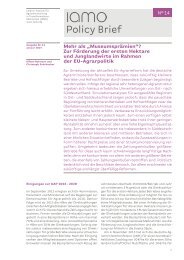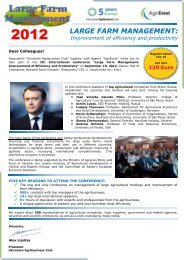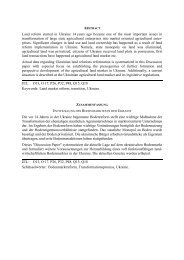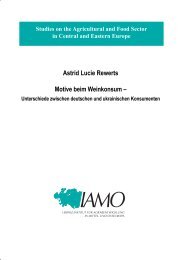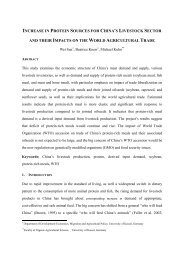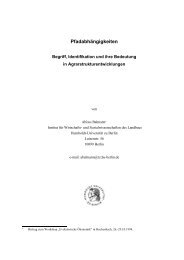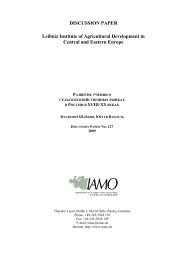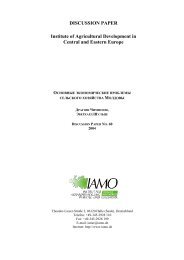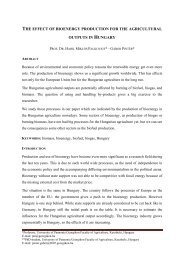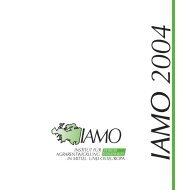Abstract - IAMO
Abstract - IAMO
Abstract - IAMO
You also want an ePaper? Increase the reach of your titles
YUMPU automatically turns print PDFs into web optimized ePapers that Google loves.
22 ANDREAS WILDERMUTH<br />
discussion is that the cost savings made possible by an efficiently run compulsory insurance<br />
scheme can make the difference between welfare-enhancing insurability of a risk and its noninsurability;<br />
always assuming that there are no permanent subsidies.<br />
This brings us to the issue of subsidisation. The successful example of the Mauritius Sugar<br />
Insurance Fund has demonstrated that some initial subsidy in the start-up phase of a crop<br />
insurance scheme can be justified. But what about permanent subsidies? The danger of<br />
permanent subsidies is that they can distort the choice of risk-management tools, in the sense<br />
that more efficient self-insurance is discarded in favour of subsidised crop insurance, thus<br />
causing a social loss (WRIGHT and HEWITT 1994, pp. 97-98).<br />
This is an important argument against subsidisation; but one has to keep in mind that in the<br />
real world with its incomplete and imperfect markets, market prices, as a rule, deviate from<br />
social opportunity cost. If these discrepancies are small, WRIGHT and HEWITT’S (1994)<br />
argument holds.<br />
But if they are large, subsidisation can be welfare-improving. If e.g. improvements in the road<br />
and telecommunication infrastructure cannot be financed due to a lack of access to credit<br />
markets, this lack of an adequate infrastructure can drive up transaction costs to such an extent<br />
that otherwise feasible insurance becomes infeasible. In this case subsidisation of the<br />
operating costs of a crop insurance scheme can be welfare-enhancing.<br />
8 CONCLUSIONS FOR RUSSIA<br />
The discussion implies that there are no convincing economic reasons for retaining the Soviet<br />
all-risk crop insurance system in the way suggested by ZADKOV (1997). The already moribund<br />
scheme should be abolished and, as in the Czech Republic, be replaced with a system of crop<br />
insurance that restricts its coverage to those perils for which cost-covering crop insurance is<br />
part of the optimal risk-management strategies for a considerable number of farms. This is the<br />
case for perils for which it is possible to find a mix of investment in information collection<br />
and incentive-compatible contract design such that for the collective of insured farms the sum<br />
of administrative and agency costs becomes lower than the cost of an alternative selfinsurance<br />
technology. Which perils meet this requirement in the particular case of Russia, has<br />
to be found out in empirical research. It will, of course, be necessary to consider the different<br />
climate zones of Russia separately.<br />
A possible candidate for an insurable risk is the sukhovei. The sukhovei is a dry and hot steppe<br />
wind, which occurs in the steppe zone of Southern Russia. The consequences of a suhkovei for<br />
plants are disastrous. If it occurs, standing grain can wither within few hours, since the<br />
sukhovei causes a grave moisture deficit on the surface of the leaves. As a rule, a sukhovei<br />
occurs too late to make a second planting possible. It can therefore cause tremendous yield<br />
losses (STADELBAUER 1996, pp. 357, 359). The sukhovei has some properties in common with<br />
hail. As in the case of hail, sukhovei damage is easily identifiable as such and measurable so<br />
that loss adjustment is relatively easy. Like with hail, the farmer cannot influence the<br />
probability of the loss event, and the only way of avoiding sukhovei damage with certainty is<br />
to relinquish crop production altogether (REINSBERG 1999). There are therefore no grave<br />
moral hazard problems. The only major difference between hail and the sukhovei (from the<br />
point of view of insurability) is that the sukhovei hits many farms at a time, i.e. the risk of<br />
sukhovei-induced crop losses is characterised by strong positive correlation across farms in a<br />
region. But as has already been said above, this is no insurmountable obstacle to insurability.



